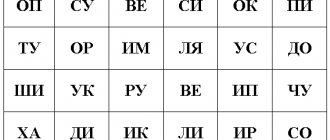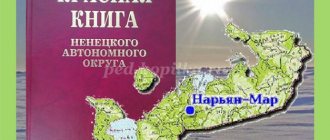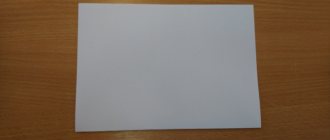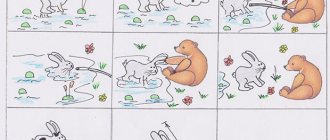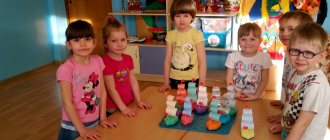Journey to the past home - home
Lesson notes for the senior group.
“Journey into the past of an object (dwelling – house)”
Goals and objectives:
Deepen children's knowledge about the history of housing; the ability to navigate the past and understand that a person constantly sought to improve his home.
Enrich children's knowledge about house designs.
Continue to introduce various building materials.
Develop cognitive interest, mental activity, imagination.
Cultivate respect for working people.
Methods and techniques:
Cognitive – research activity, productive, play.
Equipment:
cards - diagrams with dots; pictures depicting: houses (wooden, multi-story), hut, cave, yurt; "Magic wand; pebbles; bunch: straw, branches, grass; twine, a lump of clay, a bag of cement, a bowl, a jar of water, small dolls.
Surprise moment:
parsley
Preliminary work:
1. Conversation with children about fairy-tale houses and in which people live (difference).
2. Examination with children of models of people’s homes.
3. Reading fiction to children: “Winter quarters of animals”, “The Three Little Pigs”, “Bad Advice” (B. Zakhoder).
Progress of the lesson.
Educator: Today we will go to the museum to take a trip to the past home. We will find out where people used to live, where they live now, and why people have always improved their homes.
Parsley is heard crying.
Parsley enters the room, upset about something.
Educator: Parsley, why are you crying so bitterly?
Parsley: Oh, what grief! I come to the museum today, and all the models of the home are scattered, everything is lying on the floor.
Educator: Well, don't cry. Now we will pick everything up and put it in its place. Parsley: I could have installed it myself - it’s not a problem! The trouble is that I don’t remember in what order the layouts were arranged (crying).
Educator: Well, what are we going to do? Let's try to guess for ourselves where people lived before, where then and now. In front of you are cards - diagrams. Connect the dots on them and you will get images of familiar objects. What is shown in the diagrams? (At home). Guys, what are houses for? (Houses are needed to shelter from wind, rain, snow, noise, sun). Right. Previously, people lived in caves because they did not know how to make bricks. They did not have machines to help them build houses. Then people began to live in huts.
Do people now live in huts? ( No). But, for example, you went on a hike and forgot your scarf at home! And it started to rain. You could quickly make a hut and wait out the rain in it. (Yes).
Why do you think a man decided to build a hut and not stay in a cave? (It’s cold, damp in the cave, stones may fall off. And if you cook food, all the smoke remains in the cave). And it was probably also inconvenient to live in a hut? That's why man came up with a wooden house. (picture slide - wooden house) All over the world, people build houses to have shelter and protection. Houses are built from different materials depending on the climate.
Summary of a lesson on the world around us “Journey into the past of books”
Summary of a lesson on the world around us in the preparatory group
“Journey to the Book’s Past.”
Program content:
— Introduce children to the history of the origin and production of the book.
— To give children knowledge of how the book was transformed under the influence of human creativity, while maintaining essential characteristics.
— To arouse interest in human creative activity.
— Cultivate a caring attitude towards books.
Material for the lesson:
Illustrations depicting old books; knotted writing, birch bark, Egyptian papyrus, rock painting.
Illustrations of the stages of making a book, an image of a printing press. Exhibition of various books.
Illustrations with ancient capital letters drawn on leaves.
Progress of the lesson.
Children, now I’ll tell you a riddle, and you think and tell me, what is it?
She speaks silently
But it’s understandable and not boring
You talk to her more often -
You will be four times smarter!
(Book).
That's right, it's a book.
What are books for? (Listen to the children's answers). To read, to learn new things, to study at school, to be smarter. That's right, people pass on knowledge and information to each other through books.
Draw children's attention to an exhibition of modern books.
— Tell me, what kind of books are there? (dictionaries, encyclopedias, books for adults and children).
—What are books made of? (from paper).
— What parts does the book consist of? (cover, spine, pages).
—Have books always been what you think? (Not always).
-Right. Once upon a time there was a time when there were no books. The only means of preserving and transmitting information about events and people was human memory. The necessary information was memorized and “live letters” - messengers - were sent over long distances. But it was difficult to remember a lot, and then people came up with the idea of tying knots on a long rope or ribbon, then tangling it into a ball. (Show illustration). To read such a “rope letter”, you had to unfold it and run your fingers along all the knots. You can imagine how inconvenient such “rope letters” were. The knots could break, get tangled, and the knot words could be forgotten.
Then, people invented picture writing. (Show illustration). The person depicted some action in the drawing. The author could easily talk about what he drew. You can also compose such a picture message on any topic. Draw, for example, how you went for a walk with friends or parents, what happened during the walk, and what happened afterwards.
But the trouble is, not everything can be conveyed in such a drawing. One may understand it in his own way, another may understand it differently.
Gradually, people looked for new ways to convey thoughts. The man had already invented letters and knew how to write. He wrote down what he wanted to remember. What did he write on? Scientists find inscriptions on stones and rocks. (Show illustration). They are stored for thousands of years. It's comfortable? (Children's answers).
In different countries they wrote on the material that was around. For example, on clay tablets. (Show illustration). They wrote on a damp clay tablet with a sharp stick.
— Do you think it was convenient to read such books? (Children's answers). No, it's inconvenient. They are heavy and awkward to flip through.
People have also tried to write on birch bark. (Show illustration). Birch bark is the outer part of birch bark. Letters were scratched with special bone tools. However, this method of writing was also inconvenient.
But in Ancient Egypt they wrote on papyrus. This is a marsh plant that looks like a reed. Its smooth stems were cut lengthwise and laid in rows, then pressed. The result was a material similar to paper, only thinner. Large texts were written with pointed sticks on long strips of papyrus. Their length sometimes reached up to 40 meters, then they were rolled into scrolls. (Show illustration). Unfortunately, papyrus is not very durable. He only needs dry air. Therefore, the man was looking for new material for writing. It became parchment. Parchment is processed leather made from calf hides. It was stronger. For the first time, books began to be made from parchment, very similar to ours. They were very expensive, because one book required a whole herd of cows! It is clear that only a rich person could buy the book.
The paper helped the man. It was invented in China. The Chinese kept the secret of making paper a secret from other nations for a long time. And only centuries later they learned how to perform this miracle. And then the first books made of paper appeared. At first they were written by hand with a pen. Usually it was written by a person who had beautiful handwriting. (Show illustration of the chronicler).
To make the book attract attention, it was beautifully designed: pictures were drawn, capital letters were highlighted with bright colors. (Show an illustration of an old book and ancient capital letters drawn on the sheets).
It took a lot of time to write one book by hand.
— Do you think these books were accessible to many people?
— What did people come up with so that there were a lot of books? (They came up with the idea of printing).
Man invented the printing press. (Show printing press). And he speeded up the production of books. The machines cut and stitch the pages, print colorful covers and illustrations, and make the binding so that the book lasts longer.
— What do you think needs to be prepared before publishing a book? (Children's answers). Material for the book. Poets, writers, and artists are working on this. They decide what size the book will be, what it will look like, what the drawings will be.
— What professions do people work on creating a book? (writers, artists, printers, typesetters). Smart machines unwind paper from the drum, cut it, print it, chop the sheets into separate notebooks, stitch them and make binding. This is how long and difficult the journey of the book is and how many people take part in its creation.
And so the writer Leo Tolstoy tells a fairy tale. Even though the machine has no mind, But it knows business. She will cut the sheets for you herself and fold them skillfully. And the bookbinder will sew them together, trim the edges instantly, then put them in binding, and here is the book in front of you. It's nice to read books, but try to make them. Printing is a subtle art, and requires study.
teacher: - Children, how many of you know what rules must be followed so that our eyes do not get tired while reading? That's right, don't bend low, the light should fall from the left side, don't read lying down or while moving in public transport.
And now we will learn gymnastics for the eyes. Gymnastics for the eyes: We read, drew, Our eyes are so tired, Let's stand together in order, Let's do exercises for the eyes. We do eye exercises every time. Right, left, around, down, Don’t be lazy to repeat. Strengthening the eye muscles. We'll see better right away. (invite the children to follow with their eyes the movement of an object moving in different directions.) Educator: Do you know how to take care of books?
Lesson summary:
This is how long the book has come until it became what we know it now. The man was constantly thinking, thinking, carefully studying what surrounded him. Nowadays paper is made from wood. It remains the main material for writing and printing to this day.
